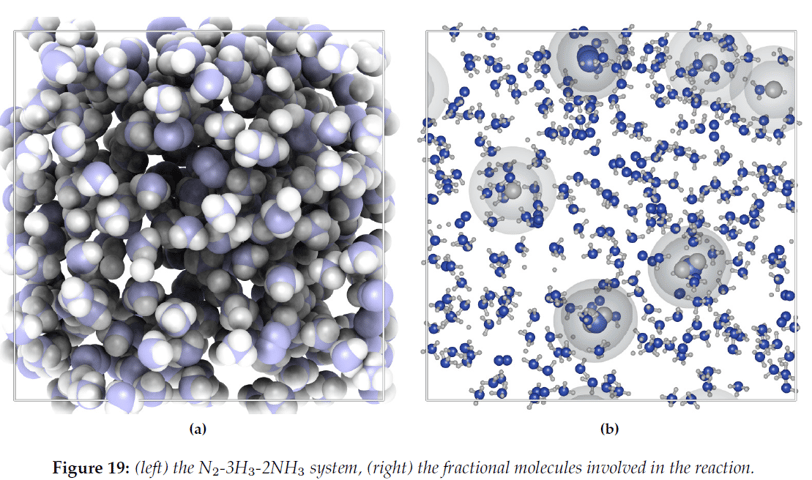How does Grand Canonical Monte Carlo work for gas adsorption simulations in computational materials science?
Grand Canonical Monte Carlo (GCMC) is a powerful simulation method widely used in computational materials science, particularly for studying gas adsorption in porous materials like zeolites, metal-organic frameworks (MOFs), or activated carbons. The technique simulates the adsorption of gas molecules at equilibrium in a system where the chemical potential, temperature, and volume are kept constant, while the number of gas molecules fluctuates.
Dr. Y. Wang @MATSEVIA, LLC
1/15/20243 min read


Image credit to: RASPA 2.0.45: Molecular Software Package for Adsorption and Diffusion in (Flexible) Nanoporous Materials, pg. 185. https://github.com/numat/RASPA2
Here’s how GCMC works in the context of gas adsorption:
1. System Setup
In GCMC, the system is defined by a fixed volume (the material's pore structure) and temperature. The gas molecules are treated as particles interacting with the material surface and with each other through potential functions, often Lennard-Jones potentials or other more complex forms.
2. Grand Canonical Ensemble
The system operates in the grand canonical ensemble, which means that the simulation allows fluctuations in the number of particles (adsorbed gas molecules). The main variables in the grand canonical ensemble are:
Chemical potential (μ): A measure of the tendency of gas molecules to enter or leave the system. This is related to the pressure of the gas in the surrounding environment.
Temperature (T): Set by the user and remains constant.
Volume (V): The pore volume of the material, which is also fixed.
The goal of the GCMC simulation is to sample configurations where the system is in equilibrium, exchanging gas molecules with an imaginary reservoir (at fixed μ and T).
3. Monte Carlo Moves
The GCMC algorithm uses random trial moves to simulate adsorption and desorption events:
Insertion: A gas molecule is randomly inserted into the pore space.
Deletion: A gas molecule is randomly removed from the pore.
Translation/Rotation: An already adsorbed molecule is translated or rotated to explore different configurations and orientations.
For each of these moves, the change in the energy of the system (due to interactions between the gas molecules and the material, as well as molecule-molecule interactions) is calculated. This energy difference is used in the Metropolis acceptance criterion to decide whether to accept or reject the move.
4. Acceptance Criteria
The probability of accepting an insertion, deletion, or a movement depends on the change in the system’s potential energy (ΔE) and the chemical potential (μ). The acceptance criteria for insertion and deletion moves are as follows:
Insertion: The probability of accepting a molecule insertion is proportional to exp(−ΔE/kT)⋅V/(N+1)\exp(-\Delta E/kT) \cdot V/(N+1)exp(−ΔE/kT)⋅V/(N+1), where V is the volume, T is the temperature, and N is the current number of gas molecules.
Deletion: The probability of accepting a molecule deletion is proportional to exp(−ΔE/kT)⋅N/V\exp(-\Delta E/kT) \cdot N/Vexp(−ΔE/kT)⋅N/V.
If a move decreases the system’s energy, it is more likely to be accepted, while moves that increase energy have a lower chance but still can be accepted (to allow exploration of the system’s phase space).
5. Equilibrium and Ensemble Averages
Over time, the GCMC simulation reaches equilibrium where the number of gas molecules adsorbed fluctuates around a stable mean value. The key output from GCMC simulations is the adsorption isotherm, which relates the number of adsorbed gas molecules (or the adsorption capacity) to the gas pressure (or chemical potential) at different temperatures.
6. Key Quantities from GCMC
Adsorption isotherms: The relationship between gas pressure and the amount adsorbed at a given temperature.
Adsorption energy: The energy associated with gas molecule adsorption, providing insights into the affinity between the gas and the material.
Loading dependence: How the adsorbed amount changes as the chemical potential (or pressure) changes.
Applications in Materials Science:
GCMC is used to predict how much gas a material can adsorb at different pressures and temperatures. This is critical for designing materials for applications like:
Gas storage: Hydrogen or methane storage in MOFs.
Carbon capture: CO₂ sequestration in porous materials.
Catalysis: Understanding reactant adsorption in catalytic materials.
Advantages of GCMC:
Accurate prediction of adsorption behavior: Since it operates at a fixed chemical potential, GCMC is particularly suited to studying adsorption isotherms.
Fluctuating particle number: Ideal for open systems where the number of molecules can vary, such as gas adsorption scenarios.
In summary, GCMC is a robust and flexible method for simulating gas adsorption in porous materials, providing detailed insights into how gases interact with materials under varying conditions of temperature and pressure.
